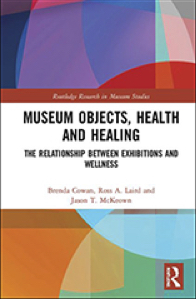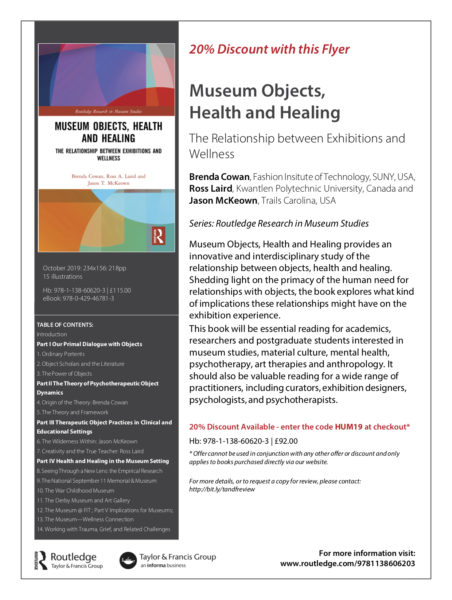Objects, Health and Healing

Read how research at Derby Museums informed work into the intrinsic wellbeing of objects.
It was a friend of mine that tipped me off to Happy Museum Project and the Derby Museum and Art Gallery. This was in 2016, as I was underway with my research into humans, objects and wellness that would come to be one of the greatest joys of my life. I had developed a theory about this human-object-health connection based on a career spent examining the power of objects in museums, and a 2015 milestone study of objects used in wilderness therapy. By the time my friend told me that I HAD to look at what is happening in Derby, I was already knee deep into discovering how very impactful museums are in people’s lives.
The theory of Psychotherapeutic Object Dynamics is a framework that identifies common and universal actions, associations, and evocative experiences that people have with objects, all of which are directly linked with mental health and wellbeing. It’s at once a bit complex, but also fairly simple. Perhaps you collect special objects, or love to give and receive gifts. Maybe you are skilled at making things, and enjoy the feeling of losing yourself in the moment of touching or creating. Maybe you give things to charity, and enjoy knowing that you are contributing to something greater than yourself alone. Some of us joyfully collect objects, or sometimes get rid of objects in a way that makes us feel a little bit lighter. These are the human-object dynamics that comprise the theory, and although these activities might not seem particularly special or important, they actually are. Very important in fact, and very much so a part of how you – how we all – foster our health and wellbeing.
If you know anything about the mission of Happy Museum Project, and the innovative exhibitions and programming at the Derby Museum and Art Gallery, then you can already see how it is that I jumped at the chance of performing a research project there. Health, wellbeing and healing are core to the mission of the museum, and I believed I would find robust examples of the theory in play. I did. Many. Joined by two insightful therapists who use objects in their practices – Jason McKeown and Ross Laird – a series of interviews were conducted in 2018 with visitors, volunteers, staff, and also people who had contributed to the museum’s collections.
Not only did we see a myriad of illustrations of the Psychotherapeutic Object Dynamics, we saw a profound and moving portrait of just how meaningful and important a museum can be to a community. To its constituency, the museum is a place of connection, enrichment and peacefulness:
“(Working in the Museum) Whetted my appetite! I feel supremely aware and excited about the other cultures. I feel revised, mindful.”
“I wanted to be a part of something, a group. You feel valued. Here there is a sense of purpose and achievement. Connecting with people.”
“I have fellow like-minded people who I get to bounce ideas off of. I’ve been enriched here.”
For some, the museum is a place where they feel a sense of permission. They can be themselves in a way that they can’t elsewhere:
“I feel proud to be photographed and showing off for the first time. I won’t be invisible. I’m leaving my mark! I have a family legacy of low profile. I don’t want to be low profile anymore.”
“(Display of the object) Is weirdly exciting. It’s putting myself out there. Out of my comfort zone. I get to be a part of the storytelling.”
“The box I put the objects in (to transport them here) is special, a statement. The objects gave me purpose and permission to use this box and to wear this coat that I typically wouldn’t.”
For many, the connection between their museum experiences and wellness was crystal clear:
“I enjoyed the experience of this (sharing with the museum). This is a continuing process of therapy that I share these things.”
“I feel more relaxed. I feel more reposed here as a result (of seeing the objects). Totally different.”
“When holding it (clay artifact) I feel contentment.”
“I specifically came here so I could participate in sharing my object (with the museum). Being a participant is important. I can just let go, be quiet. Feel respite.”
“It’s about connections. Being in the museum and being a part and with the objects improves my life.”
The study was moving, revealing, filled with essential data that demonstrate how Psychotherapeutic Object Dynamics works, and illustrative of what it looks like when a museum, its ethos, and its community become one.
Read more about Brenda’s experiences at Derby HERE.
My work with exploring the underpinnings of the human-object relationship is the subject of a new book Museum Objects, Health and Healing, co-authored with Ross Laird and Jason McKeown. It features the Derby Museum and Art Gallery case study in greater detail, as well as studies with the National September 11 Memorial and Museum, War Childhood Museum, and the Museum at FIT. Ross and Jason also provide critical information from a therapist’s point of view about how museums can successfully engage with the mental health community in meaningful and essential ways.
I imagine that you will see yourself in many of the stories and accounts that are found throughout the book. And perhaps you will enjoy knowing that your object experiences, no matter what they are, are most likely helping you navigate your life in healthful and meaningful ways.
Associate Professor Brenda Cowan

A note from the publisher.
“Museum Objects, Health and Healing provides an innovative and interdisciplinary study of the relationship between objects, health and healing. Shedding light on the primacy of the human need for relationships with objects, the book explores what kind of implications these relationships might have on the exhibition experience.
Merging museum and object studies, as well as psychotherapy and the psychology of well-being, the authors present a new theory entitled Psychotherapeutic Object Dynamics, which provides a cross-disciplinary study of the relationship between objects, health and well-being. Drawing on primary research in museums, psychotherapeutic settings and professional practice throughout the US, Canada, Bosnia-Herzegovina and the UK, the book provides an overview of the theory’s origins, the breadth of its practical applications on a global level and a framework for further understanding the potency of objects in exhibitions and daily life.
Museum Objects, Health and Healing will be essential reading for academics, researchers and postgraduate students interested in museum studies, material culture, mental health, psychotherapy, art therapies and anthropology. It should also be valuable reading for a wide range of practitioners, including curators, exhibition designers, psychologists and psychotherapists.”
More information about Psychotherapeutic Object Dynamics and the Derby Museum and Art Gallery’s contribution to the research can be found in the new book: Museum Objects, Health and Healing: The Relationship Between Exhibitions and Wellness.

